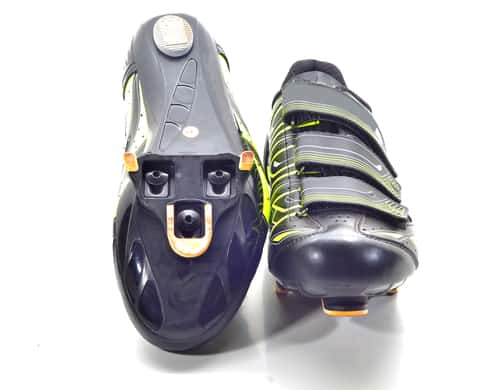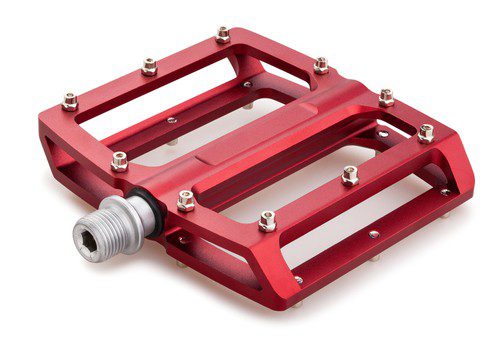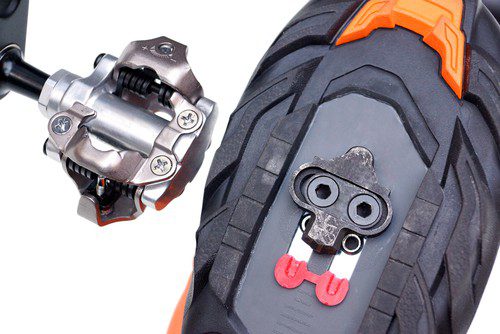While cycling shoes are not required to ride a bike, most individuals who ride regularly eventually purchase a pair. Many styles of bicycle shoes are available, and most of them include cleat attachments, which can be cumbersome for some. So is it okay to use cycling shoes without cleats?
You can use cycling shoes without cleats, and you can cycle any bike effectively without cleats. However, it will help to have flat pedals on your bike for an additional grip if you are not wearing cleats during your ride.
The article will cover the benefits and drawbacks of cleats. I’ll also discuss several alternatives to cleats for increasing your pedaling power without boosting the danger of falling off your bike.
Can You Cycle With Shoes Without Cleats?
You can cycle with shoes without cleats. All you have to do is remove the cleats from your shoes or cycle with regular shoes from the start. However, when riding clipless pedals without cleats, you may feel some discomfort and have a higher risk of accidents.

Clipless pedals are a set of specialized pedals and cleats attached to clipless cycling shoes’ soles. Once the cleats are fastened to your shoes, you step on the pedals to connect your feet to your bike.
The primary purpose of these pedals is to secure your feet in position, allowing you to generate greater power throughout the pedal stroke. These pedals are also important when accelerating and climbing.
Additionally, clipless pedals offer you greater control by allowing you to use your feet for more thrilling cycling journeys such as hopping and doing tricks.
However, since these pedals usually lack a platform, wearing shoes without cleats may result in slipping off your bike during your ride. For this reason, you should consider using flat pedals on your bike.
Flat Pedals Make Safe Riding Without Cleats Possible
Flat pedals, sometimes referred to as platform pedals, are typically constructed of rubber, metal, or plastic. These pedals are universal and may be used on any bicycle, regardless of riding style or terrain.

With flat pedals, you can ride your bike in any shoes. However, it would be best to keep in mind that clipless shoes provide less grip on these structures.
A significant worry that some individuals may have about converting to flat pedals is that they do not offer sufficient pedaling power. However, while flat pedals do slow you down somewhat, they offer a slew of additional benefits.
You can simply remove your foot from a flat pedal to place it down if necessary during a turn or while riding in wet terrain.
They give input from the bike and let you make necessary adjustments to be safe when confronted with an obstruction or bumpy road.

Lastly, and perhaps most significantly, flat pedals are safer and result in fewer serious accidents since they allow you to exit your bike when necessary quickly.
Are Cleats Necessary for Cycling?
Cleats are necessary for cycling when using a clipless pedal. These accessories improve the smoothness and efficiency of your ride. However, if you seldom cycle outdoors or attend cycling courses rarely, you can wear regular shoes.
Wearing cleats has several advantages and disadvantages that you should examine before choosing a shoe.
Pros of Cycling Cleats
There are many benefits to cleats that both beginner and expert cyclists can take advantage of, including the following:
- Cleats provide optimal power transfer.
- As you cycle or move your weight around, your feet are less likely to fall off.
- Cleats make it simpler to climb slopes. The SPD system assists you in maintaining your footing on your pedals.
- A cyclist wearing cleats accelerates and maintains speed considerably more quickly and for a longer length of time.
- If you haven’t perfected the art of bunnyhopping, being strapped in enables you to lift your wheels off the ground easily.
- With your feet clipped in, you can feel the ground and the grip of your tires. Therefore, you can make tiny changes to your body weight to better steer and manage your bike.
- According to some riders, being hooked into your pedals may make you feel more connected to your bike. Apparently, this sensation enables more fluid pedaling since your pedals and cranks become an extension of your body.
Cons of Cycling Cleats
There are also some disadvantages of cleats that you should be aware of:
- Cleats must be adjusted before usage.
- If your bike slips, the likelihood of you falling increases.
- It is inconvenient to walk in cleats. Notably, they are not designed for walking.
- If your bike fit and clipless cleats are not adjusted correctly, you risk causing severe injury to your knees and hips.
- Clipless riding is more costly. Clipless pedals, shoes, and cleats are more expensive than conventional flat pedals and sneakers.
- Having cleats adds complication to your bike setup. These attachments introduce another item to maintain and carry replacement parts for.
- There is an adjustment period while cycling with cleats. It is recommended that beginners begin with flat pedals and progress to a clipless system.
- Cleat detachment and reattachment can be time-consuming. This especially applies to those who intermittently walk with their bikes during a cycling trip.
- Adjusting the position of your foot is more complicated. To change the position of your foot with cleats, you must first stop and modify the cleats. And even then, you may not get the desired position.
Types of Cycling Shoes Without Cleats
Instead of removing the cleats from clipless shoes, consider investing in some cleat-free shoes.
Among the cycling shoes without cleats are:
- Mountain bike shoes. Mountain bike shoes feature stiffer soles for better pedaling but greater flexibility than road cycling shoes for easy walking.
- Commuting shoes. Commuter shoes are a fashionable option that combines the rigidity and ventilation of road cycling shoes with the comfort of a walking shoe.
- Flats. Their sticky rubber outsoles are designed to improve traction and cling to pedals. They are an excellent option for recreational riding, trail riding, and more technical riding.
Best Cycling Shoes To Use Without Cleats
Because your feet are one of the essential points of contact on a bike, it is critical to select the cycling shoes that suit your trips best. However, there are many options, making it difficult to determine which is the finest.
Some of the top cycling shoes from Amazon.com are listed below:
Five Ten Freerider Pro Mountain Bike Shoes
The stitched Freerider Pro features a synthetic leather top and a textured rubber covering around the toe and heel for protection.
It also has a Poron foam liner in the toe for further impact protection. Poron foam, which hardens on contact, is used in various protective gear such as elbow and knee pads.
The tongue is broad and comfy on top of the foot, with a modest quantity of cushioning.
The Five Ten Freerider Pro also has a sturdy synthetic upper, enough protection for riding in all situations, and a Stealth S1 rubber sole. The S1 compound strikes a compromise between stickiness and durability.
It’s also a very stiff shoe. This stiffness offers a number of performance advantages, including better power transmission.
This shoe is one of the finest on the market because of its grippy soles, great power transfer, sufficient foot protection, and remarkable longevity. Check out the Freerider Pro if you’re searching for a sneaker that can do it all.
Shimano SH-MT701 Mountain Cycling Shoes
The Shimano SH-MT701 shoe is flexible enough to allow for extended hours of walking while being rigid enough to feel comfortable on the pedals. This is a waterproof, multi-purpose cycling shoe designed for mountain travel, trekking, and commuting.
It is made of robust synthetic leather that will keep your footwear sturdy for many future riding excursions.
The upper portion of the SH-MT701 is constructed of mesh to offer a comfortable fit while also improving breathability and durability.
Furthermore, the SH-MT701 is SPD cleat compatible. However, unlike other versions, it does not make a clicking sound when walking, according to its users.
The flexible half-length shank with shock-absorbing EVA is another excellent feature that will improve your riding comfort. As a result, you can ride through uneven terrain with less pain in your soles.
You can find a pair online or check your local shoe store, as they are a trendy model.
Five Ten Sleuth Mountain Bike Shoes
Thanks to their inherent fabric flexibility, the Five Ten Sleuth’s mesh top offers excellent walking comfort.
The muted colors and overall design of Five Ten’s slip-on shoes should make it easy to pair them with most of your daywear.
These shoes also feature a decent degree of stiffness, which aids in power transmission. And the die-cut EVA midsole gives you a solid interaction with your pedals.
The suede leather top of the Sleuth provides excellent breathability for moderate riding. Although less breathable than mesh, the Sleuth offers enough airflow for the shoe’s intended uses, such as casual everyday bike commuting.
With a tough suede leather upper and a Stealth Marathon rubber outsole, the Sleuth is designed to last.
Final Thoughts
Cycling shoes are specially made for cycling and provide advantages that other shoes do not, such as:
- Safety
- Comfort
- Security
- Efficiency
- Improved power transmission
While these shoes are well worth the cost, the cleats that are often coupled with them may be omitted if they make you uncomfortable.
If you want to know how to have a more effective riding session without the help of cleats, Global Cycling Network offers a video that may help:
Related articles:
Are Cycling Shoes Worth It? 6 Things To Know
How And Why Road Bike Shoes Make A Difference
Are Cycling Shoes Supposed To Be Tight?


